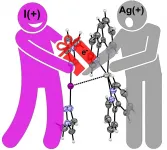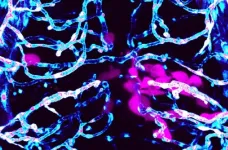New discovery could pave the way for improved treatments for diabetes
2021-02-12
(Press-News.org) Monash University researchers have uncovered the barrier to β-cell (beta cell) regeneration that could pave the way for improved treatments for diabetes and diseases that involve organ and tissue damage.
The human body doesn't repair itself very well, with our liver the only organ that can regenerate efficiently. We have limited capacity to regenerate new cells or tissue after birth as the genes involved in development are switched off.
This process happens through DNA methylation, a biological process where chemicals (methyl groups) are written on DNA and modify the way the gene functions. This modification effectively silences genes of progenitor cells (early descendants of stem cells) in the body and thereby the ability for the pancreas to generate the insulin producing β-cells.
Using mouse models, the study published in Regenerative Medicine, led by Professor Sam El-Osta from Monash Central Clinical School, found that the DNA methylation content of two key developmental genes Ngn3 and Sox 11 were diminished, effectively making them 'repair' dormant.
However, through demethylation, progenitor cells can be reawakened, restoring their capacity to become new insulin producing beta cells paving the way towards improved treatments for Type 1 and Type 2 diabetes.
"The collaboration between Dr Keith Al-Hasani and Dr Ishant Khurana has unveiled some surprising results. Their discovery that DNA methylation is a barrier to adult beta-cell regeneration will assist scientists to restore beta-cell function in the pancreas," said Professor El-Osta.
Currently, replacing the damaged β-cell mass in diabetic patients consists of whole pancreas or islets transplantation. Although efficient, these therapies face the shortage of organ donors together with the associated side effects of immunosuppressive drugs.
Current research focuses on the replacement of the lost β-cells in diabetic patients using several approaches and cell sources. However, critical to exploiting the potential of these regenerative approaches, is understanding how tissue and cellular processes are controlled during development.
Co-first author on the study, Dr Keith Al-Hasani added: "This is a novel and significant finding that will allow us to use these "sleeping beauties" (stem cells like cells) to wake up and become insulin cells to cure diabetes."
INFORMATION:
Read the full paper in npj Regenerative Medicine titled: DNA methylation status correlates with adult β-cell regeneration capacity.
DOI: 10.1038/s41536-021-00119-1
Media Enquiries
Monash Media - Wendy Smith
T: +61 425 725 836
E: wendy.smith1@monash.edu
ELSE PRESS RELEASES FROM THIS DATE:
2021-02-12
A team of researchers at Lawrence Berkeley National Laboratory (Berkeley Lab) used a quantum computer to successfully simulate an aspect of particle collisions that is typically neglected in high-energy physics experiments, such as those that occur at CERN's Large Hadron Collider.
The quantum algorithm they developed accounts for the complexity of parton showers, which are complicated bursts of particles produced in the collisions that involve particle production and decay processes.
Classical algorithms typically used to model parton showers, such ...
2021-02-12
An international research team led by Professor Kari Rissanen of the University of Jyvaskyla (Finland) and Professor Antonio Frontera of the University of Balearic Islands (Spain) has demonstrated that positively charged iodine (termed iodonium) is able to favorably interact with a silver cation (Ag+), overcoming the strong electrostatic repulsion. The research was published online in Chem -journal 8th of February 2021.
It is well known and intuitive that iodide (I-) has a strong affinity for Ag+. For instance, AgI is one of the most insoluble inorganic salts ...
2021-02-12
When we listen to speech sounds, the information that enters our left and right ear is not exactly the same. This may be because acoustic information reaches one ear before the other, or because the sound is perceived as louder by one of the ears. Information about speech sounds also reaches different parts of our brain, and the two hemispheres are specialised in processing different types of acoustic information. But how does the brain integrate auditory information from different areas?
To investigate this question, lead researcher Basil Preisig from the University of Zurich collaborated with an international team of scientists. In an earlier study, the team discovered that the brain integrates information about speech sounds by 'balancing' the rhythm of gamma waves across ...
2021-02-12
Most countries introduced school closures during the spring of 2020 despite substantial uncertainty regarding the effectiveness in containing SARS-CoV-2. In Sweden, upper-secondary schools moved online while lower-secondary schools remained open. A comparison of parents with children in the final year of lower-secondary and first year of upper-secondary school shows that keeping the former open had limited consequences for the overall transmission of the virus. However, the infection rate doubled among lower-secondary teachers relative to upper-secondary ones. The infection rate among partners of lower-secondary teacher was 30 percent higher than among their upper-secondary counterparts.
On March 18, 2020, Swedish ...
2021-02-12
T lymphocytes, or T cells, are an important component of our immune system. They can recognize foreign proteins, so-called antigens, as peptide fragments - for instance, those derived from viruses or cancer cells. In principle, they could, but usually do not, attack our own ('self') proteins. "That is why it is important for the organism to tightly control the activities of T cells," says Dr. Reinhard Obst, head of a research group at the Institute for Immunology at LMU's Biomedical Center that studies the activation of T cells. The project contributed to the Collaborative Research Center 1054 that explores the plasticity of cell fate decisions in the immune system.
When ...
2021-02-12
Scientists use many different tests to investigate what happens in the brain in people experiencing stress. It is unclear to what extent the various methods with which subjects are placed under stress are comparable to each other. In a meta-analysis, a biopsychology team from Ruhr-Universität Bochum compared 31 previous studies that had investigated stress using functional magnetic resonance imaging (fMRI). The team worked out which regions of the brain are activated as standard during stress and which stress tests trigger similar activation patterns. They describe the results in the journal Neuroscience and Biobehavioral Reviews, published online on 5 February 2021.
To conduct the work, ...
2021-02-12
The move from the ancient system of £sd coinage to 100p to £1 was controversial, considered by some to be a sign of the UK's receding importance on the world stage and even as the beginning of the tumultuous relationship with Europe that ultimately led to Brexit.
But as a result of extensive analysis of a quiet backwater of recent history, Andy argues that the move towards decimalisation had little to do with Europe and in fact was a traditional British compromise.
"It was an event that I remember from my youth, but I found that ...
2021-02-12
Biomarkers play a central role in the diagnosis of disease and assessment of its course. Among the markers now in use are genes, proteins, hormones, lipids and other classes of molecules. Biomarkers can be found in the blood, in cerebrospinal fluid, urine and various types of tissues, but most of them have one thing in common: They occur in extremely low concentrations, and are therefore technically challenging to detect and quantify.
Many detection procedures use molecular probes, such as antibodies or short nucleic-acid sequences, which are designed to bind to specific biomarkers. When a probe recognizes and binds to its target, chemical or physical reactions give rise to fluorescence signals. Such methods work well, provided they are sensitive enough to recognize ...
2021-02-12
Knowledge on how cells communicate is an important key to understanding many biological systems and diseases. A research team led by researchers at the University of Gothenburg has now used a unique combination of methods to map the mechanism behind cellular communication. Their findings can potentially improve understanding of the underlying mechanism behind type 2 diabetes.
We know that human communication is important, but communication between the cells in our bodies is just as vital. The processes where cells synchronize and coordinate their behaviour is required for an organism to function and for human organs to be able to perform their functions.
"How do cells go from monologues ...
2021-02-12
Scientists at the Fralin Biomedical Research Institute at VTC have identified a new zebrafish model that could help advance glioblastoma multiforme research. Glioblastoma is an aggressive form of primary brain tumor - fewer than one in 20 patients survive five years after diagnosis.
The research team previously discovered that human-derived brain cancer cells in mice use the brain's blood vessels like highways to spread away from the original mass. In the new study, published in ACS Pharmacology and Translational Science, they show clear cross-over between mammals and fish and describe similar observations in zebrafish.
"Our hope is that this new work in zebrafish will help researchers ...
LAST 30 PRESS RELEASES:
[Press-News.org] New discovery could pave the way for improved treatments for diabetes







